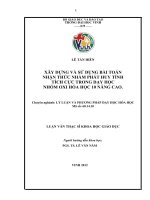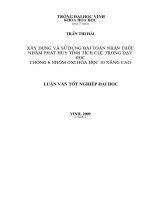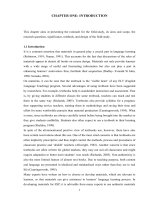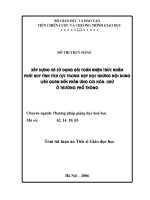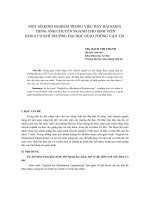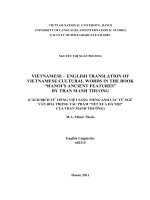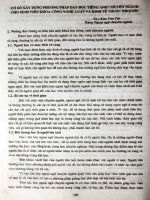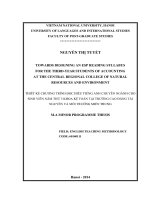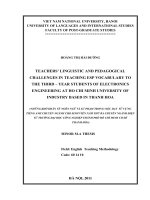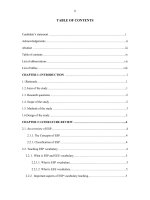SỬ DỤNG tài LIỆU CHÂN THỰC NHẰM bổ TRỢ SÁCH GIÁO KHOA trong chuong trinh day hoc tieng anh chuyen nghanh cho sinh vien y khoa nam thu 2 truong dai hoc y thu 2
Bạn đang xem bản rút gọn của tài liệu. Xem và tải ngay bản đầy đủ của tài liệu tại đây (258.91 KB, 50 trang )
CHAPTER ONE: INTRODUCTION
This chapter aims at presenting the rationale for the field-study, its aims and scope, the
research questions, significance, methods, and design of the field-study.
1.1 Introduction
It is a common assertion that materials in general play a crucial part in language learning
(Robinson, 1991; Nunan, 1991). This accounts for the fact that discussions of the roles of
materials appear in almost all books on course design. Materials not only provide learners
with a wide range of useful and fascinating information but also can play a part in
enhancing learners’ motivation- thus, facilitate their acquisition (Dudley- Evans& St John,
1998; Nonaka, 2001).
On materials, it can be seen that the textbook is the ‘visible heart’ of any ELT (English
Language Teaching) program. Several advantages of using textbook have been suggested
by researchers. For example, textbooks help to standardize instruction and assessment. That
is, by giving students in different classes the same textbook, teachers can teach and test
them in the same way (Richards, 2005). Textbooks also provide syllabus for a program,
thus supporting novice teachers, training them in methodology and saving their time and
effort for more worthwhile pursuits than material production (Cunningsworth, 1995). What
is more, since textbooks are always carefully tested before being brought into the market so
they give students credibility. Students also often expect to use a textbook in their learning
program (Sheldon, 1998).
In spite of the aforementioned positive view of textbooks use, however, there have also
been certain reservations about this use. One of the most cited concerns is that textbooks are
often implicitly prescriptive and thus might control the methods, process and procedures of
classroom practice and ‘deskill’ teachers (Allwright, 1982). Another concern is that since
textbooks are often written for global markets, they may not suit all classrooms and might
require adaptation to better meet students’ true needs (Richards, 2005). Non-authenticity is
also the most limited feature of almost text books. Due to teaching purpose, both content
and language are presented in idealized and standardized ways rather than they are in real
life (Cunningsworth, 1995).
Many experts have written on how to choose or develop materials, which are relevant to
learners, so that materials can give assistance to learners’ language learning process. In
developing materials for ESP, it is advisable from many experts to use authentic materials
1
because they can provide students with up-to -date knowledge, expose them to the world of
authentic target language, can bring the real world into the classroom and significantly
enliven the class (Martinez, 2002; Kaprova, 1999; Leloup& Prnterio, 2000; Dumitrescu,
2000). By this way, authentic materials can motivate students, give them more stimulation
in learning a language.
1.2 Rationale for the study
In Vietnam, ESP has become an indispensable branch in English language teaching in
almost all universities to meet the growing demand for communication in many fields such
as tourism, banking, science and technology and especially medicine. Therefore, selecting,
using and adapting textbooks for ESP course are much concerned issues to ESP teachers.
Given that materials development is an essential process in any language teaching
program, this study is conducted to investigate and assess authentic materials use which
give assistance to students of medicine in ESP program. Before the field- study is discussed
further, it would be helpful to provide some background for the situation of ESP program in
Vietnam in general and at Hanoi Medical University in particular.
So far English has been kept its dominant role among worldwide languages. In Vietnam,
English is considered as a key instrument in training human resource, especially, people
working at high levels need to be equipped with the English proficiency to engage in
globalize work context. Therefore, teaching and learning English, especially, ESP is a
necessity in tertiary, yet ESP is still new and very challenging to instructors. At Hanoi
Medical University, ESP has been paid more attention to recently (French used to be mainly
employed in medicine area in Vietnam). Being aware of English serving as a bridge to
connect Vietnam’s medicine to world’ advanced medicines, much attempt has been made to
improve the teaching and learning English in medicine. The principal purpose is to help
students cope with materials on Medicine in English, thus they can read medical books,
journals and other related reference materials for their further study and for their work after
graduation.
However, after some years, the materials, which has been used revealed failure to meet
students’ need and to be not very motivating to them. The materials do not appear helpful
enough to assist students to improve their medical English in terms of grammar structure
and vocabulary. They have difficulties in memorizing and using the language due to the
short diversity of grammar structures and system of content. Thus, students are not usually
engaged in the reading activities, or they do not concentrate on or involve in the reading
tasks. This existing fact has caused a headache to all teachers and some solutions have been
2
applied such as giving them some extra reading materials from some other books, but the
situation has not been significantly improved.
In an effort to search for a solution to this situation, the researcher has found that many
authors have asserted that authentic materials have a positive effect on learners’ motivation
and their language acquisition in foreign language classroom. Nevertheless, research to date
of this topic is inadequate and the researcher suggest that testing these subjective
impression- the positive effect of authentic materials on Medicine on students’ learning
process and their motivation, will result in a better guidance for the selection and
exploitation of reading materials used in ESP program.
1.3 Aims and objectives of the field-study
This field-study is firstly aimed at supplementing the findings of the earlier study by
providing empirical evidence for the effect of authentic materials on the students’ reading
proficiency and their involvement levels in class activities. Secondly, it is an attempt to
meet the need of the students at HMU for a way to access real- life language. Lastly, it is
expected that the results of the study would serve as a useful source of reference for
teachers who are teaching ESP or/ and interested in material development for ESP.
Specifically, researcher’s main objectives in carrying out this field-study are as follows:
- To introduce authentic materials as a tool to supplement the course-book to the
second year students at HMU.
- To examine the effect of the authentic materials on the students’ language
acquisition.
- To elicit students’ opinions of the authentic material use and to lay grounds for the
further research.
1.4 The scope of the study
As this is only a small- sized scale study, a number of issues, though intriguing, would be
beyond the scope of inquiry and would be best deal with in a further study, for example,
using authentic materials for other objects such as specialists, nurses or medical technicians
or designing supplementary materials on ESP program, and so on. Also, I will only focus on
the influence of authentic materials on the reading proficiency by second year students who
are trained to be general doctors at HMU.
1.5 Research hypotheses and questions
In order to achieve the above - mentioned scope, this study was designed to test the
3
following hypothesis:
H1: Students who do medical English course with the textbook and supplementary authentic materials
will make more improvement in reading proficiency measured by a proficiency test than those who do the
course with the textbook only.
The acceptance of this hypothesis would result in the injection to the following null
hypothesis or vice versa:
Ho: There is no difference in reading proficiency as measured by a proficiency test between students
who do medical English course with the textbook and supplementary authentic materials and those who
do the course with the textbook only.
In order to reach the conclusion on which hypothesis would be accepted, the answers to the
research questions that are presented below would be found.
(1) Is there a significant difference between the reading proficiency scores of the control
group (students who do the course with the textbook only) and those of the
experimental group (students who do the course with the textbook and
supplementary authentic materials)?
(2) What are students’ opinions of the use of authentic materials in extensive reading
program?
The first question is the focal point. The answer to it would yield empirical evidence for the
effect of the use of authentic materials on students’ reading proficiency. The answer to the
last question would provide invaluable information about students’ evaluation of the use of
authentic materials as supplement source on their ESP program.
1.6 Significance of the study
It has long been believed that material development plays an essential role in English
teaching. Therefore, it is hoped that the authentic materials to be used will help to facilitate
and motivate students better in ESP classes and the results of this experiment will support
the suggestion of using authentic materials and give a guidance to select and exploit
authentic materials in order to improve ESP teaching materials.
1.7 Methods of the study
The major method employed in this study to find out the answers to the proposed research
questions within the scope of the study is a quasi- experimental design which involves the
three basic components of experiments as presented by Selinger and Shohamy, that is, the
population ( second year students at HMU), the treatment ( the authentic materials use ) and
the measurement of the treatment (t- test) ( 1998, p.136). Under the present teaching and
4
learning conditions in Vietnam such as the grouping of students in advance, this method has
proved to be the best choice to yield the empirical results for this study.
Besides this main method, the class journals are collected and unofficial interviews also
carried out to students taking part in the program as well as other teachers of English and
medical specialists as a complementary tool to obtain their feedback on the program and
their suggestions for future programs.
1.8 Design of the study
The study is divided into five chapters as hereunder:
Chapter one presents an overview of the study in which the introduction, the rationale for
the study, the aims and objectives, the research hypothesis and questions, the scope, the
significance, the research method as well as the design of the study are briefly presented.
Chapter two reviews the literature relevant and closely related to the study including the
textbook evaluation, textbook use and adaptation, the features of ESP and OEP in general
and medical English in particular, authentic materials and the effect of using authentic
materials on ESP teaching and learning.
Chapter three is a detailed discussion of the method used in the study with all of its
components encompassing the justification for using the quasi- experimental design, the
variables, the participants, the design of pretest and posttest, a detailed description of
exploited authentic materials and the designing of based- task authentic materials.
Chapter four, which is the most important part of the study, presents significant findings of
the study.
Chapter five, which is not less important than the preceding one, presents a discussion of
the major findings from which some pedagogical implications were derived from. This
chapter also points out some limitations of the study that serve as the basis for the
researcher’s recommendations for further study.
1.9 Conclusion
In this chapter, an overview of the study has been presented including the rationale for the
study, the aims and objectives of the study, the scope of the study, the research hypotheses
and questions, significance of the study, the research method employed by the researcher as
well as the design of the study. The next chapter will review the relevant, closely related
literature to provide a theoretical framework for the study.
5
CHAPTER TWO: LITERATURE REVIEW
2.1 Textbook Evaluation
English language instruction has many important components but the essential constituents
to many ESL/ EFL classrooms and programs are textbooks and instruction materials that are
often used by language instructors. As Hutchinson and Torres (1994) suggest: “The
textbook is an almost universal element of [English language] teaching. Millions of copies
are sold every year, and numerous aid projects have been set up to produce them in various
countries… No teaching-learning situation, it seems, is complete until it has its relevant
textbook.” (p.315). Other theorists such as Sheldon (1988) agree with this observation and
suggest that textbooks not only “represent the visible heart of any ELT program” (p. 237)
but also offer considerable advantages for both students and teachers when they are being
used in the ESL/ EFL classroom. Haycroft (1998), for example, suggests that one of the
primary advantages of using textbook is that they are psychologically essential for students
since their progress and achievement can be measured concretely when they use them.
Second, as Sheldon (1988) has pointed out, students often expect to use a textbook in their
particular language classroom and program and believe that published materials have more
credibility than teacher- generated or “in-house” materials. Third, as ONeill (1982) has
indicated, textbooks are efficient in terms of time and money, and they can and should
allow for adaptation and improvisation. Finally, textbooks may constitute an effective
resource for learning in classroom and self-directed learning (Cunningsworth, 1995). A
learner without a textbook might be out of focus and teacher- independent.
In spite of aforementioned benefits of textbooks, however, some reservations can be found.
Some well-founded reservations pointed out by Allwright (1982), for instance, suggest that
textbooks are inflexible and generally reflect the pedagogic, psychological, and linguistic
preferences and biases of their authors. Subsequently, the educational methodology that a
textbook promotes will influence the classroom setting by indirectly imposing external
language objectives and learning constituents on students as well as potentially incongruent
instructional paradigms on the teachers who use them. In this fashion therefore, textbooks
essentially determine and control the methods, processes and procedures of language
teaching and learning. Moreover, the pedagogic principles that are often displayed in many
textbooks may also be conflicting, contradictory or even out-dated depending on the
capitalizing interests and exploitations of the sponsoring agent.
6
Other researchers such as Prodromou (1988) and Alptekin (1993) pointed out that textbooks
are often cultural artifacts because it is impossible to teach a language without embedding it
in its cultural base. However, in many instances this might alienate learners if they are
forced to express themselves within a culture they have hardly had any experience with and
been prepared for.
In addition, recent appraisals of commercially produced textbooks have also suggested that
many textbooks tend to offer classroom learners little opportunity for learning how to
properly communicate intentions such as requesting, disagreeing, complaining, and so on in
the second language (L2) (Bardovi- Harlig, 2001; Vellenga, 2004). This is firstly because
many textbook either do not present or they present communicative function (i.e. speech
acts) unrealistically. Boxer and Pickering (1995), for example, found that textbooks
generally do not contain indirect complaints (i.e. complaining about oneself or someone/
something that is not present in the conversation) as a solidarity-establishing strategy.
Bouton (1996) pointed out that the textbook that he investigated taught invitations that
rarely occur in published native speaker (NS) corpora. The reason for the unrealistic
description of communicative functions in many textbooks is textbooks are often based
largely on NS intuition about how communicative functions are linguistically expressed
instead of making use of authentic speech (Boxer and Pickering, 1985). As research has
shown, in contrast to intuition about language forms or grammar, NS intuition about
language use is generally unreliable (Wolfson, 1988) and therefore cannot adequately
inform instructional material (Boxer and Pickering, 1995).
Secondly, what also adds to the difficulty in learning how to communicate intentions via
textbooks is many textbooks seem unhelpful in teaching appropriate rules of using different
communicative functions. In order to use a communicative function appropriately, learners
need to know not only linguistic resources to express it but also the rules of use. However,
previous research has indicated that textbooks generally provide insufficient information
regarding when and for what purpose it is appropriate to make use of a communicative
function and which expressions would be appropriate in a particular situation (i.e. meta-
pragmatic information) (Crandall and Basturkmen, 2004). Teacher’s manuals,
unfortunately, rarely supplement this information (Vellenga, 2004).
Similarly, proponents of authentic classroom language models such as Brazil, Coulthard,
and Johns (1980), Levis (1999), Cathcart (1989), Bardovi-Harlig et al (1991), and Yule,
Matthis and Hopkins (1992) have also pointed out that many scripted textbook language
7
models and dialogues are unnatural and present an oversimplification of language. Thus
they tend to inadequately prepare students for the types of pronunciation, vocabulary,
grammar and discourse that are used in real world communication. While authentic material
do not automatically bring about effective learning and definitely should not be considered
more important than their relevance to learners’ needs and experience (Day, 2003), an
unrealistic and oversimplified presentation of language use can be more inhibiting than
helpful in developing learners’ language proficiency and communicative competence.
Hence, the textbook evaluation presented above has brought about an overview of benefits
and reservations textbook use that helps teachers identify the strength and weakness of a
particular textbook that is already in use (i.e. in use or retrospective evaluation). This is to
inform teachers in the process of textbook adaptation and decision- making for the next
course (Ellis, 1997).
2.2 Textbook use and adaptation
Material adaptation is one of the most concerned issues to teachers who desire to make
students’ needs and materials as well as learning process well matching. Material adaptation
is especially significant in ESP teaching where textbooks do not appear to catch up with
quick changes in terms of content and no textbooks are well- fitted enough to every
particular situation.
Various problems with materials have been addressed by a number of researchers. O’Neill
(1982: 153) suggest that the textbook can only provide props and framework for classroom
teaching and no textbook can expect to appeal to all teachers or learners at a particular level.
McDnough and Shaw (1993: 83) as well propose that textbooks, internally coherent
although they may be, they may not be totally applicable. Swales (1980) contends that any
given course-book will be incapable of catering for the diversity of needs which exists in
most language classroom. Allright (1981: 9) also maintains that given the complexity of the
whole business of the management of language learning, even with the best intentions no
single textbook can possibly work in all situations. Sheldon (1988:239) addresses a lack of
cultural appropriateness of some of some textbooks, i.e, the thinking underlying the
textbook writing may be different from or event in conflict with the assumptions held by the
teachers.
The problems mentioned above are by no means exhaustive, but the key point remains:
8
teachers, with the practical personal knowledge of their classroom teaching, should see
textbooks as their servants instead of their masters; as resource of an “ideal bank” which
can stimulate teachers’ own creative potential (Cunningsworth, 1984: 65). Adapting their
materials allow them to achieve more compatibility and fitness between the textbooks and
teaching environment, and maximize the value of the book for their benefit of their
particular learners and for the most effective teaching outcome to be achieved. It would
consequently lead to an improvement of the textbook in sense of being able to suit the
particular situation and empowering and reskilling the teachers (Apple and jungck, 1990;
Shannon, 1987). Richards (1998: 135) argues that teachers should approach textbooks with
the expectation that deletion, adaptation, and extension will be normally needed for the
materials to work effectively with their class.
For these and other reasons, there is already an established tradition of ESP teachers
adapting materials. Being aware of the crucial role material adaptation and in a big effort to
use the textbook as a resource for creativity and inspiration, a learning tool for the students
and a mean to an end in the teaching, the researcher has tried using authentic materials to
remedy weaknesses of the textbook so as to assist the students in improving their reading
proficiency as well as raise their positive attitude to authentic materials.
2.3 Materials for ESP
2.3.1 The role of materials
Since materials have a significant role, almost all methodologists have spent time talking
about materials. Mentioning the role of materials in a curriculum, Nunan (1991: 209)
asserted that:
“Materials, whether commercially developed or teacher – produced, are an important
element within the curriculum, and are often the most tangible and visible aspect of it”
The important role of teaching materials was once more confirmed by Robinson (1991)
when the author said that many writers “are in no doubt that teaching materials are
essential”.
Materials not only play an active part in a curriculum, but also are one of decisive elements
in enhancing students’ motivation. According to Dudley-Evans & St John (1998), there are
4 reasons why materials are used, which are really significant in the ESP context:
- As a source of language
- As a learning support
9
- For motivation and stimulation
- For reference
Kennedy and Bolitho (1984), on their comments on a case if the course content and the
learner’s motivation do not match, or if the level of motivation is low in the first place,
suggest that materials have to be carefully designed to raise this motivation. In another case,
these two authors also advised to develop materials in a way that they could motivate a
learner who had some initial reluctance and help him overcome the reluctance to study
English.
Especially, in some situations, where English ‘materials then play a crucial role in exposing
learners to the language, which implies that the materials need to present real language, as it
is used, and the full range that learners require’ (Dudley-Evans & S John, 1998). For
example, learners extract information from English medium subject textbooks. However, if
individual texts come from magazines, content and style will be journalistic. Therefore, the
materials need to maximize the exposure of students to the language, for instance, by
providing additional materials.
It can be concluded from the above discussions that materials are of an importance
especially in increasing student’s motivation in language learning. To do that, materials
need to expose learners to the real language, real world in which the target language is
used. Authentic materials are believed by many authors (Martinez, 2002; Kaprova, 1999;
LeLoup & Ponterio, 2000; Dumitrescu, 2000) to be the one that provides students with
opportunity to expose themselves to the real language.
2.3.2 Authentic materials
There have been a number of books and journals containing the explanations of why
authentic materials should be included in the lessons, and how it should be selected and
used or best exploited. Authentic materials should be included because they have a lot of
advantages.
2.3.2.1 Advantages of authentic materials.
The authors who support the use of authentic materials, although express in different ways,
have in common one idea: “exposure”- the benefit students get from being exposed to the
10
language in authentic materials (Martinez, 2000). The following are the benefits students
could gain from authentic materials:
First, students are exposed to real discourse (Martinez, 2002), because authentic materials
provide close contact with the language (Kaprova, 1999). In addition, language change is
reflected in the materials so that students and teachers can keep abreast of such changes. So,
it makes good sense to give our students exposure to authentic texts in the target language,
both written and oral (LeLoup & Ponterio, 2000).
Second, authentic materials introduce life into the classroom (arm students with facts -
Kaprova, 1999) as authentic materials keep students informed of what is happening in the
world, so they have an intrinsic educational value. As teachers, we are educators working
within the school system, so education and general development are part of our
responsibilities. (Martinez, 2002 cited Sanderson, 1999).
Third, they can produce a sense of achievement (Martinez, 2002), provide a bridge between
the linguistic skills of learners and their professional knowledge goals (Dumitrescu, 2000),
help to substantially recognize the real language use (as a result, they could increase their
vocabulary and language structures) (Nonaka, 2001).
Fourth, authentic materials, in their various formats, can provide a wealth of linguistic and
conceptual content to learners who are focused on specific application of their linguistic
skills (Duquette et al, 1987). Books, articles, newspapers, and so on also contain a wide
variety of text types, language styles not easily found in conventional teaching materials
(Martinez, 2002). Therefore, it is advisable to use authentic materials because they provide
the variety, which is essential in any language class, but we feel that it is particularly
important in an ESP class as there is sometimes the danger of the ESP class becoming rather
a dry affair that fails to motivate learners (Dudley-Evans & St John, 1998)
What is more, the same piece of material can be used under different circumstances if the
task is different (Martinez, 2002) and can be used to develop tasks that depart from the
formulaic language learning (Dumitrescu, 2000) and can be used at all levels (Kaprova,
1999).
In addition, they can enliven the classroom and are a powerful motivating factor (provide
11
motivation through enjoyment) (Kaprova, 1999). They can encourage reading for pleasure
because they are likely to contain topics or kinds of authentic materials to be used in class
(Martinez, 2002).
Finally, they can help increase student cultural background (Kaprova, 1999) and have an
effect on cultural identification (Nonaka, 2001).
In sum, this kind of materials if updated with the latest information on every aspect of life,
therefore, have sufficient and accurate explanations and examples. Moreover, authentic
materials present the real language, real type of materials that they will have to work with in
the future job, therefore avoid word limits and provide genuineness. As s result, authentic
materials can enliven the class and create a more positive attitude toward learning (Nonaka,
2001 quoted Duquette et al, 1987; Kaprova, 1999; Kelly et al, 2002).
Although authentic materials have plenty of advantages as discussed earlier, there remain
some reasons for that people are against the use of authentic materials.
2.3.2.2 Limitations of authentic materials
Although authentic materials have numerous advantages, they still disclose some
disadvantages. One common complaint is that authentic materials are more difficult than
non- authentic materials because of some reasons as follows according to Martinez (2002):
First, they may be too culturally biased, so unnecessarily difficult to understand outside the
language community.
Second, the vocabulary might not be relevant to the student’s immediate needs.
Third, the many structures are mixed so lower levels have a hard time decoding the texts.
Fourth, there are many abbreviations, slang, signs and the like that can require good
knowledge of the cultural background to understand.
Besides the claim of being difficult, some teachers are against the use of authentic materials
because the special preparation is necessary which can be time consuming and the materials
can become outdated easily, e.g. news, etc.
Nevertheless, these limitations can be minimized by choosing the materials selectively and
exploiting them appropriately. Many authors have given instructions on how to select and
12
use authentic materials effectively.
2.4 Features of ESP in general and medical English in particular
2.4.1 ESP in general
Dudley- Evans and St. John (1998: 4-5), in a more recent study, have modified Strevens’
definition and exposit their review on the essence of ESP from the following two
perspectives: absolute and variable characteristics of ESP from that differentiate it from
General English.
“Absolute characteristics
• ESP is defined to meet specific needs of the learner;
• ESP makes use of the underlying methodology and activities of the discipline it
serves;
• ESP is centred on the language (grammar, lexis and register), skills, discourse and
genres appropriate to the activities.
Variable Characteristics:
• ESP may be related to or designed for specific disciplines;
• ESP may use in specific teaching situations, a different methodology from that of
general English;
• ESP is likely designed for adult learners, either at the tertiary level institution or in a
professional work situation. It could, however, be for learners at the secondary
school level;
• ESP is generally designed for intermediate or advanced students;
• Most ESP courses assume some basic knowledge of the language system, but it can
be used with beginners.”
The absolute characteristics refer to the teaching methodology as well as the language
elements. ESP makes use of an underlying methodology and activities of the discipline it
serves. Both the methodology and activities used in the ESP classroom, therefore, are
different from that of GE. ESP is also different GE in that it is centered on the language that
is appropriate to these activities especially with respect to grammar, lexis, register, study
skills, discourse and genre.
The teaching procedures of ESP are linked to a view of language and learning, all activities
have to be linked to a view of text. ESP has in its brief history adopted various approaches
13
to text analysis, from the early register analysis associated with the identification of key
grammatical elements of scientific communication (Barber, 1962; Swales, 1971) to
rhetorical analysis associated with functional/notional approach (Trimble (1985) and
Lackstrom, Selinker, and Trimble (1972)) and to the dominant approach of today, genre
analysis (Swales, 1990; Bhatia, 1993). The register analysis shows an ability to use certain
key grammatical features is vital in ESP work and that other grammatical features of little
relevance to ESP work can be ignored. The rhetorical analysis first introduced the idea that
grammatical features found in specific contexts, such as an academic textbook, might
follow rules that in certain subtle ways differ from the general rules as set out in general
grammar books. This work also stresses the predominance of rhetorical considerations in
determining the grammatical choice. The notional/ functional approach at its best appears a
very fruitful method of bringing together lexical items that co- occur naturally, i.e, verbs
such as consist of and contain, with passive constructions such as attached to, connected to,
mounted on in describing the notion of structure, or items associated with the notion of
quantity, such as adequate, sufficient, enough, too much, excessive etc. The genre analysis
brings together the insights of these earlier approaches to text analysis, but also a greater
sophistication in the examination of the writers’ purpose. For example, both Fahnestock
(1986) and Myers (1990) have shown that writers in academic journals will make guarded
claims about their findings using many hedged statements (the results suggest that , the
findings appear to support the claim that ) but will use more confident statements in
popular journals tending to present claims as established facts. It can be seen that
differences in the use of epistemic modality such as down-toners, or boosters between
genres and between different disciplines create a special feature of ESP.
2.4.2 Characteristics of English for medical purposes
The theory of text analysis shed a light on identifying features of medical English as follow:
2.4.2.1 Characteristics of medical terminology
1. English medical terms derive from Greece and Latin, especially derivatives and
compound words. Quite a few elements forming word originated from Greece such as:
Prefixes: anti, auto, hyper, neo, hypo, meta, para etc.
Suffixes: ism (e), ize, logy, ma, ema, oma (carcinoma, sarcoma, neuroma)
2. Medical term are compound nouns of Latin origins:
Noun + noun: e.g. ilio-costal, laterro - abdominal
Adj + noun: e.g. mal; mal - practice
14
Multi: multinuclear
3. Medical terms are French origins
E.g. poison, physician, malady, plaque
a. Besides, we can find some other English medical terms that originate from
Italian, Spanish, German etc.
E.g. influenza, epidemic, malaria, scarlet, mosquito, Fahrenheit, protein, etc.
b. Medical terms are derivatives that consist of one, two, three, four or even
five affixes.
E.g. endocardium; three affixes included:
1. endo
2. cardi
3. um
Pneumohemopericardium; 5 affixes included:
1. pneumo
2. hemo
3. peri
4. cardi
5. um
c. Medical terms are compound nouns
E.g. sore-throat, cross-eye, outpatient
d. Medical terms are syntactic groups of noun without prepositions
E.g. Noun + noun: lungs congestion, health condition, blood transfusion
Adj + noun: spinal cord, hepatic abscess
Ordinal number + noun: first labour, first aid
P1 + noun: whooping cough, dryheating sterilization
Adv + P2 + Noun: badly fed children, sexually transmitted diseases
e. Medical terms are syntactic groups of noun with prepositions
E.g. resistance against medicine
Confinement to bed
Vaccination against the smallpox
f. Medical terms in abbreviation
E.g. SARS, AIDS, DOA (dead on arrival),
FUO (fever of unknown origin)
15
2.4.2.2 Grammatical features of English for medical purpose
Grammatical items which are dominantly employed in medical English:
1. Tenses, mood and speech
1.1. Tenses
According to the time axis, tenses in English include past tense, present tense and future
tense. Tenses show the time of the actions. In the other words, tenses indicate that the
actions happen with time.
ESP in medicine, present simple, present perfect and progressive are commonly used to
describe diseases, medical history and medical procedures. To describe diseases such as,
present simple is used like this “cholera is a serious bacterial disease spread through food
and water which has been infected by Vibrio cholerae” (Collin, 2004:71). To ask for
medical history of a woman who is in the Family planning clinic, a sentence “How long has
the coil been fitted?” is used. And to describe medical procedures doctors often say to
patients these sentences “Now the anaesthesia has worn off. We’ll give you some strong
painkillers. It’s normal to have a lot of pain at this stage.”
1.2. Mood
Mood is a set of contrasts which are often shown by the form of the verb and which express
the speaker’s or writer’s attitude to what is said or written. Three moods have often been
distinguished: indicative, imperative, subjunctive moods.
Indicative mood is the form of the verb used in declarative sentences or questions. In
medical English, declarative sentences or questions are commonly used in conversations
between doctors and patients as follow.
Doctor: How long have you got sore- throat?
Patient: For two days. My throat has swollen and it hurts when I swallow.
Doctor: Have you taken any medicine?
Patient: Not yet, I just gargle with some mouth rinse.
Imperative mood is the form of the verb in imperative sentences which are mainly used in
giving medical orders or instructions such as a doctor asks a nurse to take her patient to the
lab to do some tests or she/ he instructs her/his patient when performing a physical
examination. For instance, imperative sentences “Put your tongue out and say Ah ah!”, to a
patient or “ Take her /his temperature, please!”, to a nurse.
Subjunctive mood is the form of the verb often used to express uncertainty, wishes, desires,
etc. In contrast to the indicative mood, the subjunctive usually refers to non- factual or
16
hypothetical situations. In English, little use of the subjunctive forms remains Therefore, in
medical English subjunctive sentences are hardly used due to its nature.
1.3. Voice
According to Richards and Platts (1992: 402), voice is the way in which a language
expresses the relationship between a verb and the noun phrases which are associated with it.
Two sentences can differ in voice and yet have the same basic meaning; active voice and
passive voice. However, there may be a change in emphasis and one type of sentence may
be more appropriate. Passive voice appears the most predominant grammatical item found
in medical English. It can be seen in treatment; patient- care procedures, prevention, disease
description or diagnosis.
2.4.2.3 Syntax
Syntactically, English includes basic noun phrase and complex noun phrase, simple
sentences and complex sentences, superordinate clause and subordinate clause and main
clause which consists of clause of time, clause of condition and clause of cause and effect
and so forth. Basic noun phrase and complex noun phrase are discussed in 2.3.2.1.
Simple sentence which covers all seven structures is employed in English for medical
purpose: (I) SVO; (II) S V C; (III) SVA; (IV) SVOO; (V) S V O C; (VI) S V O A; (VII)
SV
Examples: 1. S V O
- The nervous system controls all other systems and bodily movements. (The
language of Medicine in English (p.16) )
- The technology of modern medicine has prolonged human life and reduced human
suffering.
2. S V C
- Shock is a life- threatening condition.
- Tuberculosis is preventable and curable.
3. S V A
Cancer can appear anywhere in the body. (41).
Herniated disks are most common in the lower spine (lumbar).
The patient is wheeled into the operating room. (English for nurses)
4. S + V + O + O
- Can you prescribe something for me?
- I’ll give you some herbal medicine. ((25) English for medical personnel)
17
- You’ll have to give them a blood sample, and bring the results immediately back to
me. (231).
5. S + V + O + C (positions)
I’m going to take a small sample of blood from your middle finger. (138)
- He is taking the patient to the E.N.T ward. (24).English for nurses.
6. S + V + O + A
- The electroencephalograph (EEC) records brain waves in a manner similar to the
electrocardiograph
- Nuclear medicine technicians introduce radioactive materials into the patient’s
bloodstream for diagnosis or treatment of disease or injury.
- The surgeon corrected a heart valve defect with a tiny balloon- catheter (112)
7. S + V
- He is recovering.
Kinds of complex sentence are commonly used in English for medical purpose:
According to Cob build (1990) conditional clause is used to talk about a possible situation
and its consequences. Sentences containing conditional clauses are called conditional
sentences and usually begin with if or unless. These clauses are often used to give
instructions or warning in medical English. If you have fever, unexplained weight loss,
night sweats and a persistent cough, see your doctor immediately. If you have a parent or
sibling with type 1diabetes, your chance of developing the disease increases.
Reason clauses are used to indicate the reason for something. These main conjunctions used
in reason clause are as, because, in case, just in case or since…….are often used to give
explanations on causes of diseases such as lack of insulin results in diabetes because insulin
plays an important role in making glucose – the body’ s fuel available to cells.
Time clauses are used to say when something happens by referring to a period of time or to
another event. Such adverbs of time as when, while, after, before, until… are often used to
describe symptoms or nursing, treating procedures or development of diseases. For
example, one or two days after the fever begins, painful sores develop in the mouth (Pagina,
2000). When fluid ceases to flow, remove both the needle and the syringe together
(Dougherty and Lister, 2006). You may need to lower your insulin dose before an unusual
physical activity (Epstein and Perkin, 2003).
18
CHAPTER THREE: METHODOLOGY
This chapter consists of six sections. Section 1 provides the rationale for using experimental
method and describes the research method. Section 2 presents the variables in details.
Section 3 makes the description of the participants in the experiment. Section 4 introduces
the program of authentic materials in which some descriptions of authentic materials and
extensive reading program with the materials are presented. Section 5 introduces the data
collection instrument; reading proficiency test and attitude questionnaire. Section 6 refers to
the students and teacher’ role.
3.1 Research method
3.1.1 Rationale for using experimental method
As started in 1.3, this study is an attempt to investigate the cause- and - effect relationship
between supplementary authentic materials and the student’s reading proficiency, it can
therefore, be best assisted by an experimental research method. This choice can be justified
by the fact that this method offers the luxury that others can not. According to Nunan
(1990), experiments are often carried out to explore the strength of the relationship between
variables. Also, Salkind pointed out that causal relationship between variables are
established.
It is by virtue of the experimental method itself, which allows for the control of potential
sources of differences (or variance), that the following can be said: One factor is related to
another in such a way that changes in that factor are causally related to another. So, it is not
just a relationship where two variables share something in common (as is the case with a co
-relational relationship); it’s much more. They share something, but one directly affects the
other. (Salkind, 2006: 217)
To put it in another way, an experimental method, when done correctly, can provide a
tremendous amount of power and control over the understanding of the causal relationship
between variables.
Another consideration taken by the researcher is in opting out the experimental design that
is most appropriate for the study. Selinger and Shohamy (1989) and Salkind (2006)
identified three designs within the scope of experimental method which are true-experiment,
quasi-experimental and pre-experimental designs. They are different from one another in
terms of the degree to which they impose control over the variables being studied and the
degree of randomness that enters into the design (Salkind, 2006: 218).
19
Considering those differences in combination with the present conditions in which the study
would be carried out, we decide to choose the quasi-experimental design. In detail, the
choice of the design was determined by the following factors.
In the first place, the researcher has no control over who would be in each group because
the students who would take part in the study have already been assigned prior to the study
(Salkind, 2006: 234). In this study, two groups of second- year students were assigned to
the researcher as well as a teacher by a person who is in charge of arranging the teaching
schedule for the teaching staff. Furthermore, the quasi-experimental design is more likely to
have external validity because “it is conducted under conditions closer to those normally
found in educational contexts” (Selinger & Shohamy, 1989: 149). Considering the two
groups selected in the study, they were not removed from the normal teaching and learning
context. This intactness helps to increase the validity of the later generalization of the
results to the population. Furthermore, since this design is less intrusive and disruptive than
the true-experimental design, it is easier to gain access to the subject population and thus
easier to conduct such research (Selinger & Schohamy, 1989: 149). As a result, it saved the
researcher a lot of time and effort in grouping the participants, which was impossible under
the present conditions. In short, the quasi-experimental design is the most practical and
feasible for the researcher, all above factors are under consideration.
3.1.2 Research methods
In the researcher’ attempt to conduct valid research, some measures were taken. Two groups
of student were chosen as a control group and an experimental one. And to minimize the
limitations; the differences of knowledge background and the levels of English, two groups
selected have similarities such as they are both students trained to be general doctors and
they are in groups whose English scores of the first year are not very different. The control
group did medical English course with the textbook only while the experimental group did
the course with the textbook and authentic materials as a supplement. The differences in
score between the pretest and posttest were taken into consideration when comparing the
reading proficiency in the two groups. Apart from the quasi- experimental design that acts
as the major method, class journals and unofficial interviews with students, medical
specialists were made use to collect their opinions on the valuation of the current textbook
as well as their feedback on the used authentic materials.
3.2 Variables
As mentioned earlier in 3.1, the quasi- experimental research design was used in this study
20
as a mean to establish the cause- and effect relationship between authentic materials and the
students’ reading proficiency. Therefore, a detailed discussion of those variables is
necessary. The treatment and the outcome were measured respectively by the authentic
materials use (time spent on dealing with authentic materials and the quality of authentic
materials) and the students’ reading proficiency). To put it technically, the study was
designed to examine the relationship between the independent variable (authentic materials)
and the dependent variable (the second year students’ reading proficiency and the students’
positive attitude to authentic materials).
With regard to the experimental treatment, authentic materials realized by authentic
materials program were measured by the time for dealing with authentic materials and the
quality of materials read by the students. However, our choice of the latter at the expense of
the former was determined by the following consideration.
It cannot be denied that material selection is one of the decisive factors in any language
syllabus, thus the researcher took a great care on the authentic material selection. The
advantages and disadvantages of textbooks and authentic materials are presented in 2.1. and
2.3.2. It is noted that these are the advantages and disadvantages of their own and if any
decision of which type of materials should be used has to be made, it is compulsory to take
learners into consideration. That is why learners and the relationship between learners’
conceptual and linguistic competence are discussed here.
To discuss for whom and which materials, authentic texts or simplified texts, should be
used. Kennedy and Bolitho (1984) wrote that the decision of which approach to adopt
depends on the relationship between the conceptual and the linguistic competence of the
learner, and also on the role of the English program in relation to the subject program of the
learner.
They are then further elaborated on the relationship between concepts and language. If both
concepts and language are at a low level, i.e. if the learner is a freshman in science and
language learning, then there may be a justification for using simplified materials.
If the conceptual knowledge of the learner is higher than his linguistic level, then using
simplified materials may cause offence to the learner because if the language is simplified,
the subject content is usually simplified as a result. In this case, the two authors, Kennedy
21
and Bolitho (1984) strongly suggested the use of authentic materials appropriate to the
conceptual level of the learner.
However, as suggested by Kennedy and Bolitho (1984), as much support as possible should
then be provided for the linguistic content by offering explanations in the learner’s first
language, by using diagrams and by devising carefully graded exercises.
It can be inferred that in the case of most of second year students at HMU, their concepts
and language are at a low level. It is because they have not studied their specialist subject in
their second year while their English level is supposed to be pre-intermediate. Therefore,
authentic materials must be carefully sorted out and given some adaptations.
From the above discussions, some criteria for the authentic materials could be proposed as
follows.
• First, the topics must be among the range of topics students have learnt in the
course-book to assure that they do not have to cope with both specialist knowledge
comprehension and language acquisition at the same time.
• Second, the linguistic level of the authentic materials must be a little challenging,
but achievable so that the students have to make effort in order to complete the
tasks. The appropriate linguistic level was assured by the researcher and her
colleagues when choosing the authentic materials based on their teaching experience
and their awareness of the students’ level of English.
• Third, the text types of the authentic materials need to be the genres that the students
will have to deal with in their future employment. The information about the
appropriate text types was found through unofficial interviews to the medical
specialists.
• Fourth, the tasks accompanying these materials to be authentic, that is, the activities
the students will have to do in their future work.
In this study, the values of this independent variable were defined from the students’ class
journals and their post reading activities which include summary, role play, history cases,
diagnosis report or close exercises. All these post class values were then summed up to
yield the final one for later analysis.
22
In reference to reading proficiency, there were not many choices of variable as authentic
materials since the reading proficiency test score has been widely assumed to be valid. What
mattered, if there was, would be the construction of the proficiency test used. To ensure the
reliability and validity of measurement of reading proficiency, a test that is considered to be
standard for doing this job was designed and administered (see 3.5.1 for detailed description
of the test)
3.3 Participants
The sample included two groups of second- year Vietnamese students who are trained to be
general doctors and study English as a foreign language at HMU. They were selected firstly
on the basis of cluster sampling.
This method of sampling had some advantages given the conditions under which the study
was carried out. On the one hand, since students were enrolled from a wide residential and
family background and homogeneously grouped, the relatively high degree of
representatives was ensured. This contributed to the increased validity of the later
generalization to the whole population. On the other hand, since students were already pre-
assigned to groups prior to the study, the removal of any individual from one group to
another was impossible. Therefore, cluster sampling proved to be convenient, inexpensive
and time- saving (Salkind, 2006: 92-93).
As a result of cluster sampling, the two sample groups were, however, not the same in size,
which numbered 32 and 29 respectively. The participants were relatively homogeneous in
age which was ranged from 18 to 20 and all of them did English course of general science
in medicine. Nevertheless, their starting point of learning English at HMU was medical
English so we have no chance to balance their general English therefore, some extra
grammar and vocabulary home work given as a remedy measure. Moreover, those medical
English courses are often provided before the participants study their specialist subject
presents both advantages and disadvantages. Almost the participants appear curious and are
eager to explore their specialist knowledge in English. The new and interesting explorations
do enhance their motivation in learning English yet unfamiliar topics create some
difficulties in their language learning. In sum, these students’ features were representative
of the second-year students who were studying English as foreign language at HMU who
made up the targeted population of the study.
23
3.4 Reading materials
3.4.1 Non - authentic materials
As mentioned in 3.2, the non- authentic materials employed in this experiment were the
reading texts taken from the textbook, units taken from Let’s Examine the Text by David
Werner (1977) were chosen for the study. A sample for reference is provided in
Appendix… Basically, each unit has a reading text accompanied by the same kinds of
exercises and it organized as follows:
The pre- reading stage starts with some words as clues for students to predict the content of
the text, or some pre- reading questions to generate interest and give students a reason for
exploring the topic.
In the while- reading stage, the exercises are designed to give students chances to practice
new words in the context of the reading or to identify word types and to recognize reference
words. The part of this stage is a series of comprehension questions which ask for specific
information from the reading to help students review the main points of the reading. Some
of the questions require students to make inferences based on the information presented in
the reading.
Since all of the texts in the textbook do not have post- reading activities, in all the text
chosen for this experiment, post- reading activities are designed to remedy the weakness of
the textbook. The detailed description of the extra reading materials is presented in 3.4.2.
3.4.2 Authentic materials
As mentioned in 3.2, authentic materials were the reading texts collected from different
sources; medical journals, American doctors’ handbooks and the internet by the researcher
with the help of medical specialists at HMU and Vietduc hospital.
However, there are two types of language that medical materials written in are the
languages for the professional and non-professional. The materials for specialists are likely
much more difficult to understand due to not only professional language but also
complicated content. Accordingly, it is so hard for teacher of English and the students who
have not had much medical knowledge to digest. That is the reason why authentic materials
for the non-professional were chosen for the program.
24
The criteria for selecting the authentic materials are mentioned in 3.2. In this part, the
researcher would like to summarize them as follows:
• The topics must be among the range of topics students have learnt in the course-
book to assure that they do not have to cope with both specialist knowledge
comprehension and language acquisition at the same time.
• The linguistic level of the authentic materials must be a little challenging, but
achievable so that the students have to make effort in order to complete the tasks.
The appropriate linguistic level is assured by the researcher and her colleagues when
choosing the authentic materials based on their teaching experience and their
awareness of the students’ level of English.
• The text types of the authentic materials need to be the genres that the students will
have to deal with in their future employment. The information about the appropriate
text types was found through unofficial interviews to the medical specialists.
• The tasks accompanying these materials to be authentic, that is, to be the activities
the students will have to do in their future work.
All the chosen reading materials based on the students’ language proficiency and the
medical specialists’ recommendation weekly provided for students as “at home” reading.
Comprehensive reading exercises are also included in each reading text that help students to
get information, contact, predict new medical terms then remember them after the lesson
After students reading thoroughly and writing summary of these readings, post- reading
activities are organized to get them involve as well as for teacher to check how well they
read at home. Post- class journals were collected to get students’ feedback for materials
adjustments.
3.4.3 Applying authentic materials in extensive reading program
As Nuttall suggested (1982) “the best way to improve your knowledge of a foreign
language is to go and live among its speakers. The next best way is to read extensively in
it”. And in fact, authentic materials has traditionally been defined as that written for native
speakers, that is, ordinary everyday materials not provided specially for language teaching
purpose. Therefore, authentic materials are a useful, appealing resource for people who read
extensively to explore and expose themselves to the target language.
25
